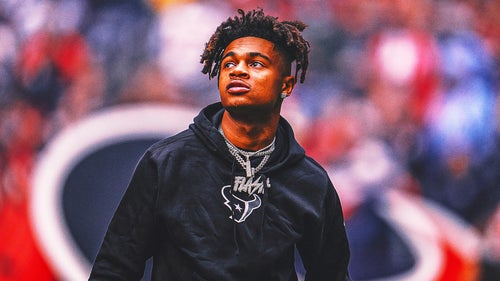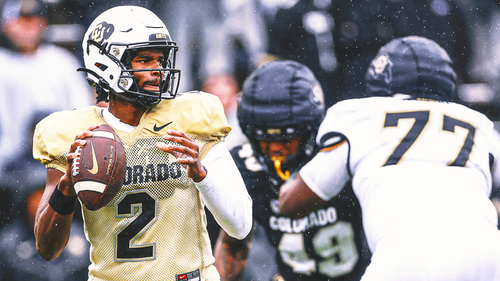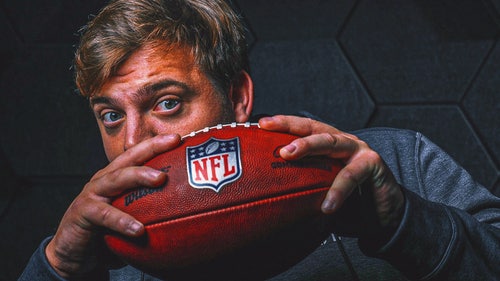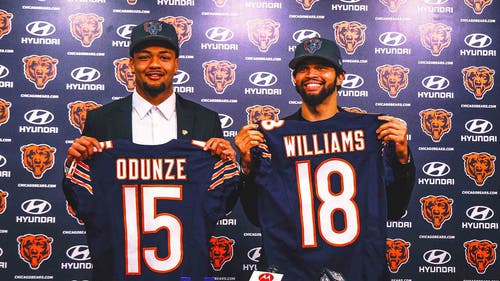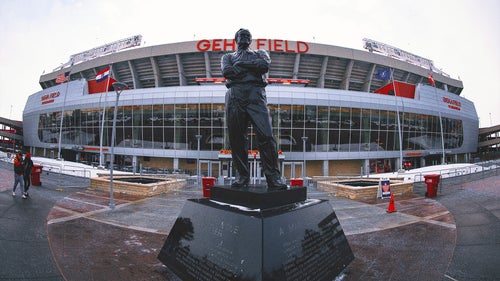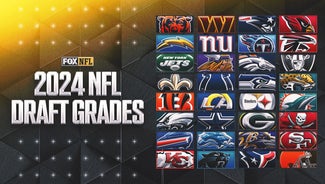
Inside the Bears’ offensive overhaul, and how it could help Caleb Williams
There's a new offensive coordinator in Chicago. Shane Waldron arrived following the Bears' dismissal of Luke Getsy after the team's 7-10 season in 2023, and Waldron brings years of experience. He deploys a physical offense that focuses on the basics and works its way up. The hope in Chicago is that Waldron and his scheme will fit right in. Heck, Soldier Field's main parking structure is the "Waldron Deck." No adjustments needed.
In an attempt to figure out how this is all going to go for the Bears, you must first understand the city itself. I grew up outside Chicago and spent some of my formative years living within the city limits. To know Chicago is to love it.
"Hollywood is hype. New York is talk. Chicago is work."
That's a famous quote from Michael Douglas waxing poetic about Chicago.
It's the city of broad shoulders. A city that says, I will outwork you. A city that's proud of its blue-collar roots. A city so persistent, it could burn to the ground and would still rise. And did.
Chicago works. It's all Chicagoans want to do.
That attitude permeates throughout the city's many neighborhoods and is exemplified in no better way than its teams. Sports are ingrained in the very fabric of the city. And the city is symbiotically ingrained in its beloved teams.
That's why the founding franchise of the NFL, the Chicago Bears, could see so little success for so long and yet still have so much support — so much hope surrounding it. It's why heated arguments rage on social media and sold-out crowds roar inside Soldier Field. It's why the Chicago Bears are still known as the "Monsters of the Midway."
Those Monsters are now at a crossroads.
On "The Pat McAfee Show" recently, Bears GM Ryan Poles was asked to address former quarterback and current analyst Robert Griffin III's comment that USC's Caleb Williams should "pull an Eli Manning" and refuse to go to Chicago at the top of the 2024 NFL Draft.
"It pisses me off a little bit, to be honest with you, because we were hired to break a cycle," Poles said. "The same thing when I was in Kansas City … and we did, and no one talks about those days anymore."
The Bears' tear down, and subsequent rebuild, started with Poles' arrival in 2022. The roster almost completely turned over in a year. The second year saw improvement on head coach Matt Eberflus' side of the ball, as the defense soared to a top-five unit by the end of the 2023 season. The offensive overhaul has continued this offseason with the installation of Waldron and the decision to trade QB Justin Fields after his third season in the league.
It was a slow but steady process meant to build a foundation for sustained success, something the city has been starving for throughout the better part of four decades. It was team-building the hard way. But Poles and the Bears believe it was the right way.
The inside of Halas Hall now reflects the city outside of it — or about an hour south, anyway. The culture in the building is tough, gritty and physical.
"You just humble yourself coming into the building," said cornerback Jaylon Johnson when asked about Caleb Williams on "Up & Adams." "You can't bring that Hollywood stuff into the building, especially not with guys who have played the game at a high level for consecutive years. … We going to see through that."
We know the defense has bought in, but the question remains with the offense.
So how is it going to work?
The offense
Waldron's scheme encapsulates that physical mentality. Waldron, in blue and orange, is going to bring a black-and-blue style back to the NFC North. Players in his scheme play a very physical brand of football, starting up front with the offensive line and the mid-zone run scheme. Mid-zone plays off the idea that it's hard to block a defense straight up, so it aims to widen the defense, or stretch it, with running backs cutting back inside to the vacated space left behind.
Waldron's scheme is friendly to the big guys on the offensive line, as a result. It thrives off double teams and actively stresses staying on them, with two linemen often working through multiple levels of the defense. These zone blocks will open the cutback lanes for running backs, who should have good vision of the field and the ability to change direction easily.
This blocking scheme also incorporates tight ends as the basis for most concepts. Waldron uses a heavy rate of 12 and 13 personnel. Last year, Waldron's Seahawks offense ran 12 (one running back, two tight ends, two wide receivers) 22.3% of the time, which was the 13th-highest rate among all teams. But Seattle had the second-highest rate of 13 personnel (one running back, three tight ends, one wideout) at 9.4% of plays, according to FOX Sports research.
Multiple-tight-end sets bring base personnel out of the defense. There aren't many defensive coordinators out there who see the matchup problems tight ends create and decide to throw out a lighter defense against more than one of them. This results in heavy boxes — often eight or nine men — that Waldron's offense can now exploit.
Exhibit A:
It can also come in the form of tight end leak plays or simply winnable matchups for the one or two receivers who are on the field.
Using tight ends, as opposed to running backs like Kyle Shanahan likes to do in San Francisco, can give the offense even more flexibility. This is especially true if you have multiple "Y" tight ends who can both block and catch. Despite the team already having a proven starter in Cole Kmet, it's not a coincidence that one of the Bears' early free-agency additions this offseason was veteran tight end Gerald Everett, who has played four seasons under Waldron. I expect Chicago isn't finished adding at the position either.
Even when there aren't multiple tight ends on the field, Waldron often puts his tight ends off the ball. This creates space between them and their assigned defender if the defense is in man coverage, or it widens the player's possible zone if the defense is in zone coverage. After all that, that tight end can also just block or be used as a decoy.
For all the confusion that can create among opposing defenses, the scheme itself is relatively simple — at least to start. There are essentially four plays the entire system builds from: mid-zone runs to the right, mid-zone runs to the left, naked bootlegs to the right and naked bootlegs to the left. That's it.
Where Waldron's mastery really shows is in his deployment.
There's a difference between a coach who can call plays and one who can call games. Waldron is the latter, and he comes to Chicago with five years of coordinator experience. He was the pass-game coordinator for the Los Angeles Rams from 2018 to 2020 and then the offensive coordinator for the Seahawks from 2021 to 2023. Calling a game means that while the scheme starts off simple, it evolves throughout each game and, in a broader sense, throughout the season. Watch closely and you'll even see more gap scheme come into play later in the year just to keep opposing teams honest.
"The best thing that they do is they match the play-action game off the run game," said an NFC defensive coach about Waldron's offenses. "You see a lot of teams do play-action stuff where they obviously try to make it look like a run play, but the run play they're selling, they don't do in real life. So it's obvious, but those guys [Waldron and his players] have done well with what they do."
The same coach went on to tell me one of the last times his team faced Seattle, Waldron ran the ball on third and long multiple times as the game was winding down in a shootout.
"The only other guy I've seen have the balls to do something like that is [Detroit OC] Ben Johnson."
The formations Waldron throws out there look almost redundant, but he will end up calling a dozen different plays out of those formations. That approach makes it nearly impossible to predict in-game and avoids showing tendencies on tape later.
That brings me to one of the bigger drawbacks of the offense. In order to solidify double teams, the offensive linemen basically must sell out and stay on their assignments, otherwise the entire protection is off. This means that if defenses check into something else post-snap or somehow do get a read on what an offense is about to run, very little can be done post-snap to counter it.
The good news is, as far as passing goes, a lot of it is built around play-action — which can delay pressure — or quick game, if the offense is in an empty formation with no one in the backfield. In fact, 35.5% of Geno Smith's pass attempts last season (150) were short throws between 0-10 yards, according to FOX Sports research. Naturally, 71% of his throws were fewer than 20 yards (a total of 300 pass attempts). But what's fun is he still had 76 attempts of 30 or more yards. Waldron likes to pick his spots.
Waldron's scheme requires buy-in from the whole offense. Tight ends aren't the only receivers asked to block. Wideouts have to do it, too.
Physical, remember?
Deep shots tend to come off bootleg plays, which is where some athleticism from the quarterback is needed.
So, what does that look like for a young QB? Maybe one out of USC? Taken with the first pick in the 2024 NFL Draft?
The quarterback
Much has been made about Heisman-winning USC quarterback Caleb Williams in Chicago already. He's the presumed choice for the Bears, who hold the first pick in the draft, as Williams is widely considered the top prospect in one of the best quarterback classes in recent years.
His talent isn't up for debate, though it has somehow being overlooked due to off-the-field noise. Williams is seen by some as too flashy, too emotional, too "Hollywood." He paints his nails, puts a pink case on his phone and has sought out his mother for comfort. But he's been able to back up and handle the hype despite being so young and with millions of dollars at his disposal in the second-largest media market in the country.
"I'm having a hard time finding someone who doesn't like him or even love him," said Poles at the owners meetings in Orlando.
Sure, Williams' fashion choices are a little unorthodox, his personality a little boisterous and his mind is already on business. But in an NIL generation, this is the new normal, as one NFC assistant general manager told me.
"Transactional approaches until trust is earned."
That executive went on to say that a business-like approach by prospects and even "snowplow parents" are of no concern when he evaluates a player.
In some ways, this provides a real-world test, almost like a practical Wonderlic, that actually helps evaluation.
"For some, they blow through the money and struggle to manage it," said one NFC college scouting director. "[NIL] actually helps NFL teams realize that about these kids before the teams are the ones paying them."
"One of the ways that I try to evaluate guys is this: How do I see this person/player responding when adversity hits?" said one NFC player development executive. "Like when he's 5-for-21 with two picks, how's he going to respond? Reason being is that in the NFL, adversity is in the cards for everybody. It's not if he struggles but when he struggles."
Williams did see struggles at USC. A season after winning the Heisman and throwing for 4,537 yards, 42 touchdowns and just five interceptions, his stats took a hit. Williams found himself playing hero ball more often than he probably would have liked while the Trojans ended up with an 8-5 record, going 5-4 in the collapsing Pac-12.
"He did not have an ideal supporting cast, from wide receivers to offensive line," explained the NFC assistant GM. "Or a complementary defense."
So much of Williams' highlight reels show him making something out of nothing, often resulting in a big throw, off platform, far after the original play had broken down.
And yeah, those are fun.
Though he's had some fumble issues, Williams has also taken care of the football through all this backyard ball he's had to play. Usually, when a player is accused of playing too out of structure, the concern is recklessness. That doesn't happen with Williams. He had only five interceptions again last season. He threw 30 touchdowns, too.
The crux of what many want to know, though, is if Williams has the ability to play within structure and get into a rhythm. You have to look beyond those highlight reels to see that.
Williams threw at his pro day with the reported intent of showing all those in attendance (which included almost all relevant Bears personnel) that he could, in fact, throw from the pocket.
Now, there was no pocket because there was no offensive line, or defensive line providing pressure, nor defensive backs contesting Williams' teammates who were catching his passes. But the fact that Williams wanted to quell those concerns should be encouraging in and of itself.
"I think he can learn, and if he's coached to do it that way, I think he will be good," said one NFC quarterbacks coach.
The fit
Here comes the good stuff. Should Williams indeed be the Bears' pick, and should he get on a plane to the Windy City to helm Waldron's offense, what would that look like? Is it a good pairing?
Let's see.
USC's offense last year deployed a lot of heavy offensive personnel. There were a lot of multiple-running-back sets, as well as some multiple-tight-end sets, which we know Waldron loves. What was perhaps most encouraging is that there were a lot of off-ball tight ends even when the offense was in 11 personnel (one running back, one tight end). The heavier personnel was used as a means of opening up the run-pass option, or RPOs and play-action. It's all very similar to what Waldron will be running in Chicago.
In the mid-zone scheme Waldron deploys, a lot of work is done with a lead blocker, again something that Williams saw with the Trojans. It helps to get movement from the strong-side linebacker, known as the SAM, to identify things for the quarterback. That's where extra tight ends come into play in Waldron's offense, in particular.
It also seems as though USC's offense was predicated on a zone scheme with a few foundational plays. Just check out these two back-to-back plays from the Stanford game last season.
Then there's the deep ball. We know Williams can throw it; he did it at his pro day. But he's done it in games, too.
And if all that should fail, if the protection should break down due to the defense switching up or if someone misses his assignment, you have a guy under center who can do this — on fourth-and-1 in a close game against the fifth-ranked team in the country, no less.
Between Waldron as the new offensive coordinator, the Bears investing heavily in the offensive line as well as experienced pass-catching weapons in DJ Moore and now Keenan Allen, plus multiple tight ends with varying skill sets in Kmet and now Everett, Chicago looks to have a pretty filled-out offense.
The offensive line has long been a sore subject among Bears fans, but in Waldron's offense, all the double teams make it pretty big-man-friendly. Chicago added not one but two veteran interior offensive linemen in Ryan Bates and Coleman Shelton. The latter started all 17 games for the Rams last season. Bates was someone Poles had his eye on in the GM's first offseason with the team, but Buffalo matched his offer sheet from the Bears and retained him. Now, Poles gets his guy for depth. The team also brought in offensive tackle Matt Pryor, a swing tackle who will provide depth as well.
The biggest splash of the Bears' offseason came in the signing of running back D'Andre Swift to headline a backfield that also includes Khalil Herbert and Roschon Johnson. In theory, these players all have complementary skill sets, which they'll need. They'll also need to increase their physicality in Waldron's offense, which frequently calls upon backs to help in pass protection, though it's often made easier with multiple tight ends on the field.
The Bears finally seem set up to put it all together. Their patience and persistence are on the precipice of paying off.
This could actually work, and that's all Chicago has ever wanted.
Carmen Vitali covers the NFC North for FOX Sports. Carmen had previous stops with The Draft Network and the Tampa Bay Buccaneers. She spent six seasons with the Bucs, including 2020, which added the title of Super Bowl Champion (and boat-parade participant) to her résumé. You can follow Carmen on Twitter at @CarmieV.








































































































































